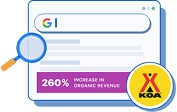You’ve created content, published it, and maybe even shared it across multiple channels content marketing. But here’s the big question, is it actually working?
Not just in clicks or likes, but in real outcomes: engagement, conversions, growth.
We believe in making data-backed decisions. Guesswork is risky business. A robust content marketing audit cuts through the fluff and shows you what’s truly resonating and what’s just… noise.
And this is where content marketing audit tools become indispensable. They track performance, reveal insights, and show you how to optimize, not just for search, but for real people.
You may have different reasons to use the tools you need; you may be optimizing a high-traffic blog or a low-converting landing page, but the truth is, the right tools make all the difference.
Content Marketing Audits 101: Why You Can’t Ignore Them
If content is king, then a content audit is the king’s advisor, quietly guiding decisions behind the scenes, shaping strategy, and determining what’s truly valuable.
Yet, too many businesses skip this critical step, focusing instead on creating more content rather than optimizing what already exists. The result? Wasted resources, internal content cannibalization, and a marketing strategy that’s working harder, not smarter.
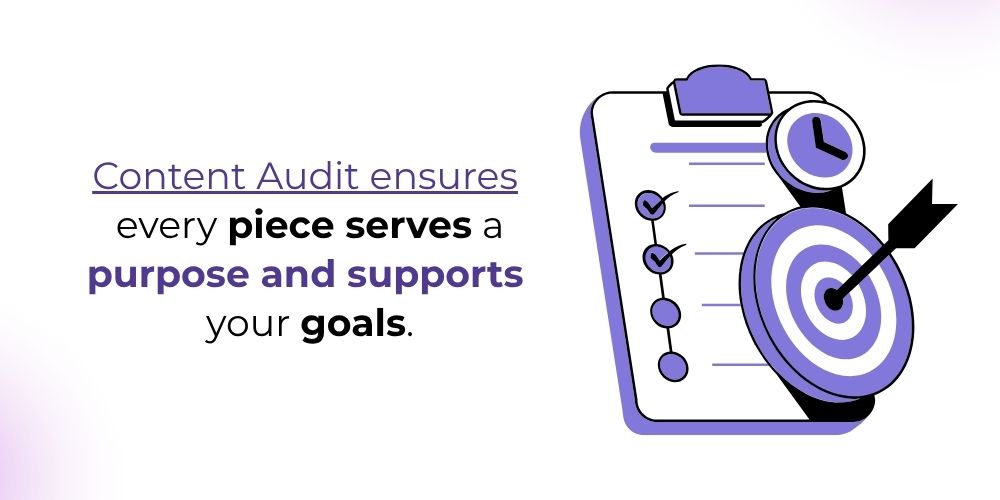
So, what exactly is a content marketing audit?
At its core, a content audit is a comprehensive review of every piece of content you’ve published, blogs, website pages, landing pages, videos, social media posts, even email campaigns, with the goal of evaluating performance and impact.
It’s not about simply counting what you have. It’s about discovering what’s working, what’s outdated, and what’s missing.
A well-executed audit pulls back the curtain on your entire content ecosystem. It answers questions like:
Which pieces are bringing in traffic?
Traffic without conversions can be misleading. A good audit doesn’t just look at top-performing pages; it assesses why they perform well and how they contribute to the customer journey.
What content is outdated or irrelevant?
Old, underperforming content can drag your SEO down. Identifying pieces that are no longer accurate, aligned with your brand, or valuable to users helps you clean house, and sometimes, revamping just one post can double your traffic.
Are there content gaps in your buyer journey?
Every stage of the funnel should have tailored content, from awareness to decision-making. Audits highlight missing touchpoints and help align content to actual user intent.
What’s driving conversions (and what’s not)?
It’s one thing to get people on your site. It’s another to get them to take action. A content audit connects performance metrics to business outcomes.
Let’s ground this in reality. One of our clients, a sustainable fashion brand, had been publishing three blogs a week like clockwork.
Yet, their traffic remained flat. Through an audit, we uncovered a major issue: 60% of their content was targeting the same keywords, resulting in internal competition and diluted visibility.
After pruning low-performing posts, consolidating overlapping topics, and tightening their keyword strategy, their traffic tripled in six months.
The reality about content audits is that it isn’t about doing more. They’re about doing better.
Without regular audits, your content strategy is like a cluttered attic, full of potential, but mostly collecting dust.
Decoding the Metrics: What You Should Really Be Measuring
A content audit is only as powerful as the metrics behind it. Track the wrong ones, and you’ll end up chasing vanity. Track the right ones, and you’ll get crystal-clear guidance on where to invest your time and budget.
Let’s break down the key metrics that truly matter:
1. Traffic & Engagement
Your content might be beautiful, but if no one sees it, or worse, if they bounce instantly, it’s not doing its job.
- Pageviews & Unique Visitors show how many people are discovering your content.
- Average Time on Page indicates how engaging your writing is.
- Bounce Rate tells you whether visitors are sticking around or abandoning ship after one glance.
These engagement signals reveal how your audience is interacting with your content.
For instance, a blog with high pageviews but a 90% bounce rate might be attracting clicks with the wrong promise, misleading titles, irrelevant intros, or slow-loading pages.
2. SEO Performance
If your content isn’t ranking, it’s not working for you, it’s just existing.
- Keyword Rankings let you track upward or downward movement in search visibility.
- Backlinks show how credible your content is in the eyes of Google and other publishers.
- SERP Features (like featured snippets, image packs, and People Also Ask) signal high content quality and authority.
We once audited a fitness coach’s blog and found that most posts had weak headers, missing meta descriptions, and zero internal linking.
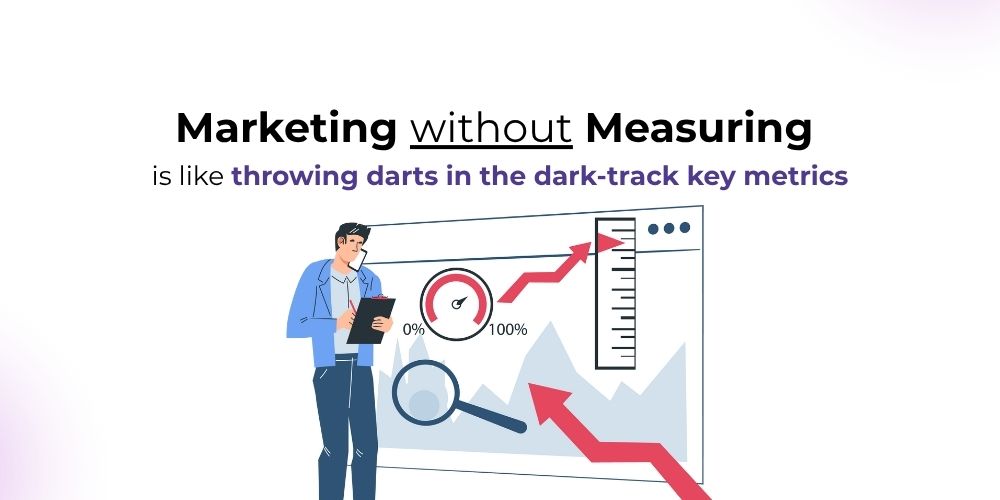
Just by fixing these technical issues, no rewrites, no new content, five of their blog posts made it to Page 1 of Google within 45 days.
3. Conversions & Lead Generation
Traffic is nice, but leads pay the bills. The most effective content drives action.
- CTA Clicks tell you if people are motivated by your message.
- Form Submissions show actual interest.
- Downloads, Quiz Completions, or Newsletter Signups are indicators of valuable, trust-building content.
One education-sector client saw a 400% increase in leads after embedding a simple quiz at the end of a blog.
The audit revealed their audience preferred interactive content, and a quiz turned into their best-performing lead magnet, outpacing whitepapers and webinars.
4. User Behavior Analytics
Want to see beyond the metrics? Behavioral data tools like Hotjar, Microsoft Clarity, or Google Analytics heatmaps offer a peek into how people actually use your site.
- Scroll Depth shows how far users get before losing interest.
- Click Maps reveal what parts of your page draw attention, and what gets ignored.
- Exit Pages tell you where users drop off in your funnel.
This level of insight is pure storytelling through data. For instance, if users consistently scroll past your CTA without clicking, maybe it’s placed too early, isn’t compelling, or gets lost in the design. Knowing how users behave helps you fix not just content, but experience.
The Toolbox: Must-Have Content Marketing Audit Tools
Let’s talk tools. A well-run content audit hinges on having the right tech stack. But not all tools are created equal, each plays a distinct role. Here’s how we break it down at The Meta Future.
SEO Auditing Tools: The Technical Health Check
Your content might be brilliant, but if it’s buried on page 5 of Google, it’s invisible. SEO auditing tools help uncover what’s stopping your content from ranking.
Top Tools:
- Ahrefs: Great for backlink audits and keyword gap analysis.
- SEMrush: Excellent for technical SEO audits, position tracking, and competitor benchmarking.
- Screaming Frog: A favorite for crawling your site and identifying broken links, missing meta tags, duplicate content, and more.
Use Case: These tools help you identify technical errors (like slow page speeds or crawl issues), spot sudden ranking drops, and assess the health of your backlink profile.
They provide the foundation for understanding where your content stands in the eyes of search engines.
Performance Analytics Tools: Data That Speaks Volumes
Great content delivers results, and these tools tell you how well yours is doing. They track real user behavior and show which content is actually moving the needle.
Top Tools:
- Google Analytics (GA4): Still the gold standard for traffic patterns and engagement.
- Matomo: A privacy-focused alternative with robust tracking capabilities.
- HubSpot Analytics: Excellent if you’re already using HubSpot for inbound marketing.
Use Case: These tools measure bounce rates, session durations, goal completions, and traffic sources.
Want to know if your blog leads to newsletter signups? Or if people are spending 3 minutes or 30 seconds on your product page? This is where you’ll find out.
Content Quality Evaluation: Beyond the Metrics
You can have SEO-optimized content with great traffic, but if it reads like a robot wrote it, you’re missing the mark. Quality evaluation tools help elevate your content’s clarity, tone, and engagement factor.
Top Tools:
- Grammarly: For grammar, clarity, and basic readability checks.
- Hemingway: Helps simplify complex sentences and boost overall readability.
- Clearscope: Combines readability analysis with semantic keyword optimization.
Use Case: Whether you’re adjusting tone to suit your buyer persona or optimizing content for readability, these tools ensure your content feels as good as it performs.
Content Inventory & Audit Templates: Get Organized, Stay Sane
The biggest challenge of content audits? Keeping track of everything. That’s where structured audit templates and inventory tools come in.
Top Tools:
- Airtable: A flexible, spreadsheet-database hybrid perfect for tagging, sorting, and assigning.
- Notion: Great for building customized audit dashboards with team collaboration.
- Google Sheets: Simple, scalable, and perfect for templated audits.
Use Case: Use these tools to create a centralized audit hub, catalog content assets, assign scores based on performance and quality, track updates, and build action plans.

We at The Meta Future often combine these into a custom dashboard that gives us a snapshot of performance at a glance.
How to Conduct a Content Audit Step-by-Step (Without Overwhelm)
A full content audit can sound like an enormous task, but when broken down into bite-sized steps, it becomes manageable (and surprisingly satisfying).
Here’s how to do it:
Step 1: Inventory Everything
Start by collecting every piece of content across formats, blogs, landing pages, videos, PDFs, email campaigns. Dump everything into a spreadsheet.
Pro Tip: Use columns like:
- Title
- URL
- Content type
- Publish/update date
- Primary goal (lead gen, SEO, brand awareness)
- Target keyword
- Performance metrics (traffic, conversions, etc.)
This content inventory is your audit’s backbone.
Step 2: Measure Performance
Now it’s time to plug in the numbers. Using your analytics tools, fill out performance metrics like:
- Page views
- Bounce rate
- Time on page
- Conversion rate
- Keyword position
- Backlink count
Real Example: We once audited over 200 pages for a health-tech startup. Just 30 of them were responsible for 85% of their inbound leads. That insight allowed us to double down on the winners, and retire the rest.
Step 3: Identify Opportunities
Now that you have the data, segment your content into four buckets:
- Keep: High-performing content that’s still relevant.
- Update: Content that has potential but needs a refresh (new stats, better CTAs, updated SEO).
- Merge: Multiple pieces on similar topics? Combine into one comprehensive guide.
- Delete: Outdated, irrelevant, or thin content that’s dragging your site down.
Step 4: Plan Your Actions
Create a clear roadmap:
- Assign tasks to team members.
- Set deadlines for updates.
- Prioritize by impact and effort.
Mindset Shift: Don’t treat content as disposable. Every blog post, video, or landing page is a potential long-term asset. Approach your content like a digital real estate portfolio, maintain, upgrade, or flip.
Spotting Content Winners and Losers: What the Data Tells You
One of the most rewarding parts of an audit? Unearthing hidden gems.
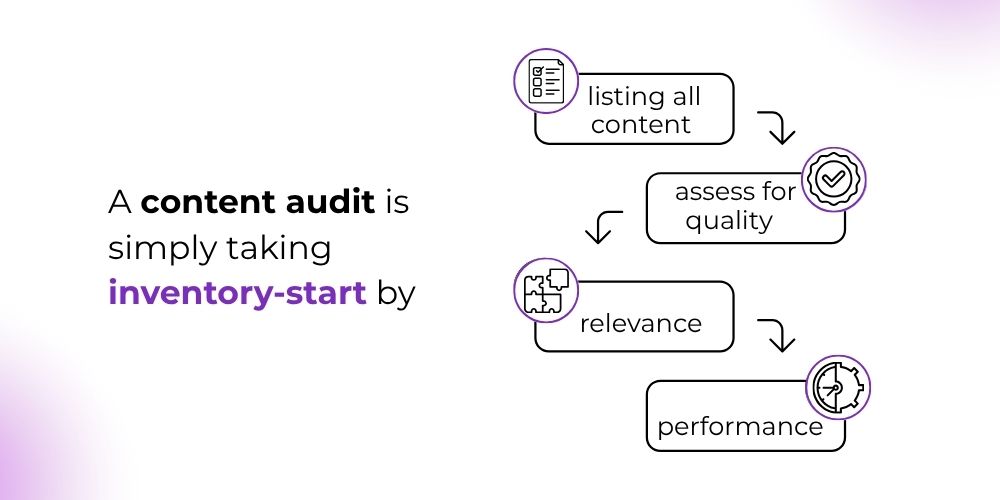
That blog post from 2021 that’s still pulling in thousands of monthly visitors? That’s a content winner.
How to Spot the Winners:
- Top 10 pages by traffic
- Content with high time-on-page and strong conversion metrics
- Pages ranking in the top 3 on Google for target keywords
Next Steps for Winners:
- Refresh the content with current data
- Update visuals and media elements
- Add internal links to newer or strategic content
- Repurpose into videos, carousels, infographics, or podcast episodes
These pieces are already working, give them more visibility and watch them scale.
What About the Losers?
These are pieces with:
- Low or no traffic
- High bounce rates
- No keyword visibility
- Outdated information or broken links
Ask Yourself:
- Is the topic still relevant?
- Can this be improved with better SEO, UX, or visuals?
- Would merging it with another post help?
Case Study: We worked with an ed-tech brand to merge five underperforming blogs into one mega-guide.
Within 30 days, that new guide ranked #2 on Google and started bringing in qualified leads, proof that “losers” can be turned around.
Case Study Spotlight: Brands That Boosted Growth Through Content Audits
Sometimes the smallest changes lead to the biggest wins, especially when those changes are backed by data. That’s the power of a content audit.
Let’s explore how two very different businesses transformed their performance by auditing their content.
Case Study #1: A Nutrition Startup’s Road to 4x Traffic
The Challenge:
Despite publishing weekly blogs, this growing nutrition startup saw no significant movement in organic traffic. They had content, lots of it, but it wasn’t doing its job.
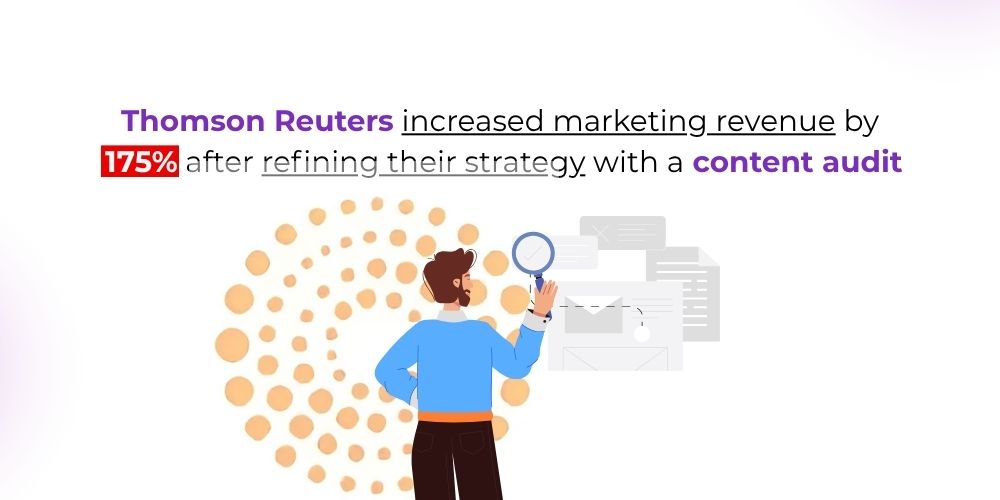
The Audit Insight:
A comprehensive content audit revealed that nearly 70% of their blog posts weren’t targeting any specific keywords. They were writing for their audience, but not for search engines. This meant their content was invisible on Google, no matter how well-written it was.
The Fix:
We overhauled their approach:
- Mapped each blog to a relevant keyword with meaningful search intent.
- Optimized metadata (titles, descriptions, alt text).
- Updated older content to reflect recent trends and science-backed facts.
- Created a cohesive internal linking structure to enhance crawlability.
The Result:
In just five months, their organic traffic quadrupled. Not by publishing more content, but by making their existing content work smarter.
Case Study #2: Corporate Training Company Boosts Lead Gen by 80%
The Challenge:
This company was producing quality thought leadership content but wasn’t seeing the leads flow in. Traffic was decent, but conversions were underwhelming.
The Audit Insight:
The audit uncovered a hidden problem: their CTAs (calls to action) were either buried at the bottom of the page or too vague to prompt action. In some cases, there were no CTAs at all.
The Fix:
- Rewrote CTAs to be clear, benefit-driven, and visible.
- Added content upgrades, downloadable PDF checklists and templates that aligned with blog topics.
- Implemented simple lead capture forms with minimal friction.
The Result:
Lead form submissions jumped by 80%. The difference? Clarity, placement, and added value.
Content audits don’t just identify problems, they turn assumptions into data-backed decisions. No matter if you’re struggling with traffic, conversions, or SEO visibility, an audit often uncovers the silent killers you didn’t know existed.
That’s where the real magic begins.
Common Mistakes to Avoid During a Content Marketing Audit
Let’s be honest, content audits can be powerful tools, but only if done right. Too often, marketers go through the motions and miss the bigger picture.
Here are the common pitfalls that can derail your audit, and what to do instead:
Obsessing Over Vanity Metrics
Pageviews and impressions might look good on reports, but they’re often hollow victories. The real question is: What are those views doing for your business?
If the content isn’t generating leads, engagement, or moving users down the funnel, it’s not performing, no matter the traffic.
Better Focus: Prioritize conversion metrics, dwell time, scroll depth, and assisted conversions. These show intent and real engagement.
Ignoring Mobile Behavior
Today, more than 60% of users access content via mobile. If your pages are slow to load, difficult to navigate, or poorly formatted for small screens, you’re losing out.
Audit Tip: Always include mobile performance as a key factor. Use tools like Google’s Mobile-Friendly Test or PageSpeed Insights to identify UX bottlenecks.
Skipping Competitor Benchmarks
You don’t operate in a vacuum. If you’re not evaluating your competitors, you’re missing key opportunities, especially in SEO and thought leadership positioning.
Real-World Example:
We once ran a competitor audit for a legal tech brand. Their top competitor ranked for 15 long-tail keywords the client had completely ignored.
That insight led to an entirely new blog series, capturing a fresh segment of search traffic and brand visibility.
Lesson: Don’t just benchmark. Outperform.
From Audit to Action: Turning Insights into Results
A content audit isn’t just a tidy spreadsheet with color-coded scores. It’s a strategic tool, a roadmap that bridges where your content is and where it needs to go.
Here’s how we help clients turn audit insights into tangible results:
Set SMART Goals
Instead of vague ambitions like “grow traffic,” define clear targets:
- Increase blog-generated leads by 25% in Q2
- Reduce bounce rate on high-exit pages by 15%
These measurable outcomes help you stay focused and evaluate impact effectively.
Plan and Prioritize Optimizations
Not all content is created equal. Start with the pages that:
- Get the most traffic but convert poorly.
- Rank just below Page 1 on search (positions 11–20).
- Have outdated or thin content.
Game Plan: Revamp 10 blog posts a month based on opportunity and impact, quality over quantity.
Test, Measure, Iterate
Great content marketing is never static. Use A/B testing to optimize:
- Headlines and meta titles
- CTAs and lead magnets
- Content formats (e.g., video vs. text)
Track what moves the needle, then double down on it.
Conclusion
Your content has one job: drive results. But without a clear view of what’s working and what’s not, you’re flying blind.
A proper content marketing audit brings clarity, focus, and strategy to your content engine. It helps you:
- Remove underperforming clutter
- Refine high-potential assets
- Align with what your audience and Google actually want
In a world where attention is scarce, the brands that win are the ones who make every word count.
Because here’s the truth: Data doesn’t lie. And smart marketers listen.


